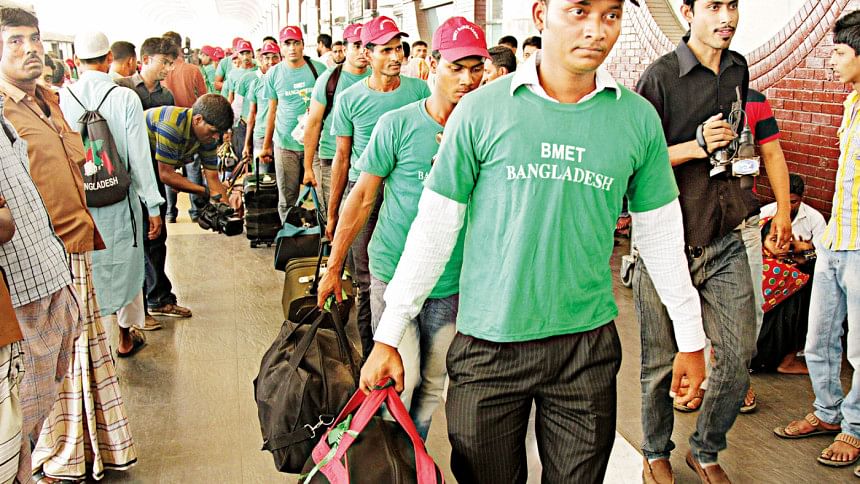Leveraging remittances for driving the next stage of growth

Remittances have multipurpose positive effects on rural economies, which enhances Bangladesh's inclusive growth, according to economists.
Primarily, it boosts the consumption-driven economy, which ultimately improves the rural non-farm economic activities, they said. Therefore areas that successfully earn more remittances improve in economic and non-economic activities too, they focused.
Remittances have direct and indirect effects on the economy, said KAS Murshid, former director general of Bangladesh Institute of Development Studies (BIDS).
"Since the money goes directly to rural households, this boosts the rural economy through injection of increased liquidity, increased consumption, and savings," he said. "Macroeconomic impacts of remittances are also substantial through support provided to the balance of payments."
In other words, remittances boost growth and the growth is widely shared.
Bangladesh is featured in the list of top 50 recipients of remittance inflows in the world. The country retained its position as the seventh highest recipient of money transferred by migrant workers in the world; India remains at the top.
The hike in remittances from more skilled Bangladeshi migrants could be a windfall for Bangladesh and its migrants said the World Bank report on remittance that was published last week. Remittance is important for low-income countries as a dominant source of foreign exchange, it said.
The significance of remittances in its economies ranged from 6 to 8 percent of GDP for Bangladesh, the report said.
Although remittances rose above pre–COVID-19 and 2020 levels by almost 6 percent to reach USD 23 billion in response to the government's tax cuts and other incentives in 2021, slowdown in growth is distinct, the report added.
"Remittances have multilateral impact on inclusive growth of Bangladesh," said Prof Abdul Bayes, former Chairman of Department of Economics at Jahangirnagar University. "The impact is mostly consumption led and it pushes the rural demands."
He added, "Remittance has an impact household directly, especially on their consumption. So, demand for goods and services rose in peripheral areas." Bayes was the former director of the Research and Evaluation Division of Brac,and co-authored the book Rural Transformation: Insights from Bangladesh with Mahabub Hossain.
"Now, rural demand depends on good harvesting and remittances, and if one of them are impacted then it impacts the economic activities," he said.
With better harvesting and remittances, non-farm economic activities and boosted in rural areas. If non-farming activities are strong in an area then its internal migration is lower.
Although some of the remittances are spent on loan repayment in the first stage, later it goes to land, housing etc.
After a period, people invest in entrepreneurship, he said, adding that some initiative is needed to accommodate the remittances into investment in a planned way.
"The government can come up with steps for bringing remittances into investment," Bayes added.
"Remittance reduces poverty undoubtedly, which is a major impact of remittance," said Binayak Sen, director general of BIDS. "Though, sometimes, it raises inequality as people don't get the chance to go abroad." He added that the situation has changed as many lower income people are now going to earn foreign currency.
With the remittances, agricultural mechanisation has accelerated in the rural areas, he continued.
"Women are also taking part in agricultural entrepreneurship. If they are given loans and advised to get more technology," he added, "then the utilisation of remittance will be higher."
Atiur Rahman, former governor of Bangladesh Bank, said remittance inflow has a significant impact on our micro and macro economies.
"In particular, the rural economy has been benefiting a lot in terms of increased consumption and investment in micro, small and medium enterprises," he said. "More than 60 percent of our growth originates from consumption which has been kept buoyant by robust financial inclusion aided by remittance."
"The phenomenal growth in rural non-farm income owes a lot to consistent inflow of remittance. The macroeconomic impact of remittance has been even more important. Along with export, the remittance has been balancing the external payments and supporting robust imports," he added, "at times it has helped create surplus in current account balance."
He said the growth in foreign exchange reserve could be attributed to remittance, which has been helping Bangladesh in undertaking larger investment in infrastructure. He also added that, until recently the exchange rate of dollar against taka remained stable for many years.
Rahman stated that due to a sudden spurt in post-pandemic imports opening up of the economy, and enhanced foreign visits by our people, the balance of payment has been under pressure with gradual depreciation of taka.
"This, I think, is a transitory development which will improve as more remitters go back to their work places," said Rahman, who is also executive chairman of Unnayan Shamannay. "The export has started picking up; so will remittance."
He added, "Inflation might show its ugly face for some time. However, oil prices are being stabilised and I am sure we will regain our strength in external economy shortly. The central bank will have to remain engaged to bring back the balance with prudent interventions."

 For all latest news, follow The Daily Star's Google News channel.
For all latest news, follow The Daily Star's Google News channel. 



Comments